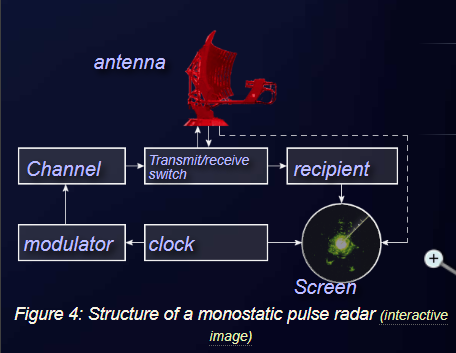The structure of a pulse radar depends on whether the transmitter and receiver are located in the same location (monostatic radar) or whether both components are operated in completely different locations (bistatic radar).
In addition to its compact design, monostatic pulse radar has the advantage that timing control, which is important for pulse radar devices, can be concentrated in a central synchronizer block via a radar trigger system. The internal propagation times of the synchronization pulses can thus be kept short. A complex radar antenna can be used in the multiplexing process for both sending and receiving. The downside is that at the time of transmission, the very sensitive radar receiver often has to be turned off by a transmit / receive switch for its own protection.
In a bistatic pulse radar, the receiver, with its own antenna, is in a different location from the transmitter. This has the advantage that the receiver can be operated without significant protective measures against excessive transmission power. In the simplest case, a network of additional receiver locations is configured for a monostatic pulse radar. Receiving antennas are not very direct: they must be able to receive from several directions at the same time. The downside here is the very complex timing. The receiver must also receive the direct transmission signal in parallel with the echo signals and generate a synchronous signal from it and from the known distance to the transmitter. The main area of military application of bistatic configurations are radars over the horizon (OTH radar).
A variant of bistatic radar are passive radars. They parasitically use various HF broadcasts (radio or television stations or third-party pulse radar devices) and calculate the target position from the difference between the time of direct reception of a signal and the additional running time of echo signals. Measurement ambiguities can be ruled out, on the one hand, by directly targeting interference emissions from the target or by synchronizing two passive radars operating in different locations.
